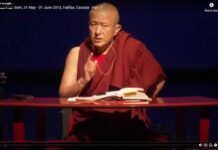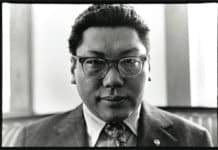Read the Vidyadhara’s comments about his will.

I. If Shambhala is not fully realized
A. Will
Birth and death are expressions of life. I have fulfilled my work and conducted my duties as much as the situation allowed, and now I have passed away quite happily. It might cause you grief, sadness; nonetheless you should carry on with what I have created and continue my vision. On the whole, discipline and practice are essential, whether I am there or not. Whether you are young or old, you should learn the lesson of impermanence from my death.
My writings are for the students; therefore they should be respected. However, I would like to ask that no one act like Ouspensky and try to systematize my work. The monumental objects should be cherished and kept. The household articles should be treated as special, under the guidance of Lady Diana. I have never conducted myself frivolously, so all my collections should be regarded as objects of learning.
The children should be raised in pure Buddhist fashion. Their education is very important. Therefore both the schools and the home up-bringing of the growing sangha members should be taken care of by the parents, or friends, for that matter. The sangha members should not quarrel or create any friction. They should regard themselves as brothers and sisters. The people who have served as ambassadors and plenipotentiaries should be respected.
Needless to say, the Regent is the regent, the dharma heir. The sangha members should help him maintain his sanity and good behavior. The connections with the higher tulkus in Rumtek should be maintained. Maybe they could help supervise the sangha at this time. The relationships with other Buddhist organizations should be kept continuously friendly. On the whole, the expansion of Vajradhatu should be one of the most important focuses. My death should not prevent or slow down any vision.
B. Funeral Ceremony
If the legalities permit, the sangha should witness the body in samadhi. This is demonstrated by rigor mortis, heat in the centre of the chest and lack of tenting of the skin (or maintenance of normal tautness). Immediately after death the body should be bathed in saffron water and clothed in the formal brocade chuba. Then it should be positioned upright in meditation posture and left alone until the end of samadhi, when the bodily fluids escape through the nostrils and rigor mortis subsides. No autopsy should be performed and the undertakers should not be permitted to embalm the body or interfere with it in any other way. Offerings of flowers and light should be arranged around the body. The seed syllables of the armour devis should be written on small pieces of paper and placed on the appropriate parts of the body.
During the samadhi, the sangha should chant the Guru Yoga of the Four Sessions, and then they should practise either shamatha-vipashyana or mahamudra, depending on the individuals’ level of practice. If time permits, the sadhakas might perform the Vajrayogini Sadhana, including both the self and front visualisations.
After the samadhi is completed, the body should be cremated. It is not such a good idea to use a commercial crematorium; it would be preferable to cremate the body in a place like R.M.D.C. During the cremation itself, either the Chakrasamvara or Vajrayogini sadhana should be performed in the form of a fire puja. It would be a good idea to have one of the Rinpoches from Rumtek preside over the ceremony. If the heart or any other part of the body jumps out of the crematorium, that should be preserved and placed in a container inside a choten or monument of some kind at R.M.D.C. After the cremation is completed, a search for the shariras should be conducted, and they should be placed with the other relics inside the choten.
II. If Shambhala is fully realized
A. Will
The Sakyong is not dead. The Great Eastern Sun is still shining. The Rigdens have merely decided to give a rest to the present Sakyong, the Dorje Dradul of Mukpo.
It is sad to leave our warriors and the kingdom in its full glory. The Shambhala world might feel empty and desolate without its leader. Nonetheless, we have appointed a member of the younger generation to inherit Shambhala, and he has been trained and educated in the proper manner. We are proud of that achievement. The Sakyong’s power should be distributed among the ministers and the Katham Sikyong, as well as the Ashe Prince and the Sakyong Wangmo. However, it is the Ashe Prince who will have the ultimate say. It is he who holds the sense of command. He is the one who will appoint the ministers, dapons, and so on, so he should not be manipulated by political struggles. Needless to say, the Ashe Prince has to be trained further by the cabinet and the Katham Sikyong: he has to learn about the vicissitudes of life, and he has to pay attention to how to rule. At the same time, he shouldn’t be hassled by too many demands, although it is his responsibility to pay attention to the problems of both home and foreign affairs.
The Sakyong Wangmo should be treated as a consultant. If there are any disagreements, she could help solve the conflicts. We have been training the Sakyong Wangmo from her teenage years up to full maturity, so she knows our thought patterns. She can be critical sometimes or, for that matter, stubborn; but she means everybody well. She is occasionally reluctant to act, but in this event she might not be, because there will be no one to consult except herself. She should respect and pay attention to the Ashe Prince, regarding him as truly the Sakyong. On the whole, the government should treat her as our substitute. When you trust her further and obey her commands more, she will become strong, powerful, and reasonable.
Prince Gesar should assume his seat as a Buddhist leader. When Prince Ashoka grows up, we would like to see him become the next Katham Sikyong. Needless to say, he has to go through much training, both Eastern and Western. We have great hopes for him, because he is intelligent, cunning, and willing.
We would like to express our interest in the further development of the secretariat. After our death, there should be no disappointment among the personnel of the government of Shambhala, and we should make sure that nobody falls away. Another interesting point is maintaining the public security systems, such as the desung and the kasung forces. They should not act in either too authoritarian or too meek a way, but rather, they should keep their place and maintain their discipline of being gentle and ruthless at the same time. The welfare of the citizens should be good and excellent. Nonetheless, we should not be too mercenary. The general dignity of the people, as well as the industries, should be maintained as we have done already.
What we have done should not be mimicked or copied, but emulated. The national assembly should be watched very carefully to make sure they do not lose heart. They should maintain their Shambhala style without becoming North Americanised. Loyalty should be understood so that we do not become democratic. The other religious groups should be respected, whether they are Christian, Jewish, or Moslem. Any new ideas about economy, gadgets, and art should be watched very carefully. In short, we should not mimic others’ so called successes, because our style is slightly different.
Altogether we are happy to die. We take our joy along with us. It is unusually romantic to die:
Born a monk,
Died a king-
Such thunderstorm does not stop.
We will be haunting you, along with the dralas.
Jolly good luck!
B. Funeral Ceremony
Immediately after death, the body should be bathed in saffron water, then dressed in the white abhisheka uniform. It should be placed, along with a suehiro, a sword, and a relic box containing some black pills and some of His Holiness’ salt, into an open coffin, made of cedar and bearing the governmental crest of Shambhala. The rings and watch should be taken off of the body and passed on to the next Sakyong, along with the yantra and the taplong. Other than this, the body should not be disturbed during the samadhi.
When the body has been laid out, an honour guard of four kasung and four kusung should be placed around the open coffin. The kasung should stand in the four principal directions, one on each of the four sides of the coffin; and the kusung should stand in the intermediate directions, or at the corners. The honour guard fulfills the same function as placing the armour devis in the Buddhist funeral ceremony.
Protected in this manner, the body should be left on display, while the subjects file by and place flowers. The subjects should practise the Werma Sadhana during the samadhi, either in the same room as the body or nearby. The tulkus from Rumtek could likewise practise pujas.
The formal funeral should be held as soon as possible, preferably during the samadhi or just after the samadhi has ended. All the foreign diplomats and statesmen that we have cultivated should be invited. We would like to request that Mr. John Driver, our English instructor from Oxford, be present. Some representatives of the press are welcome, but not an excessive amount. Sorting out who to invite or not is the prerogative of the Katham Sikyong and the minister of foreign affairs.
After the dignitaries have been assembled and the various addresses have been made, the visitors could file by the body and place flower offerings or otherwise pay their respects. The funeral should conclude with cannon shots, totalling the number of years that the Sakyong has lived. Then the military bugle corps should play the anthem.
After the funeral, the body should be buried, not cremated. This should be regarded as a blessing of the land. A burial site should be chosen where a memorial tomb could later be erected. Quite possibly the memorial could contain a carved statue of the Sakyong lying in state, as was done in earlier days of the Western tradition of monarchy.
Read the Vidyadhara’s comments about his will.






